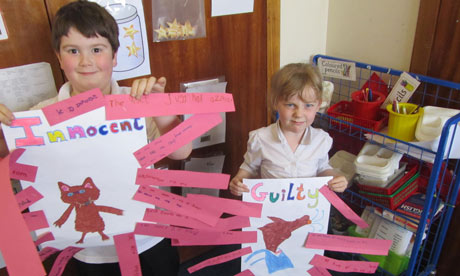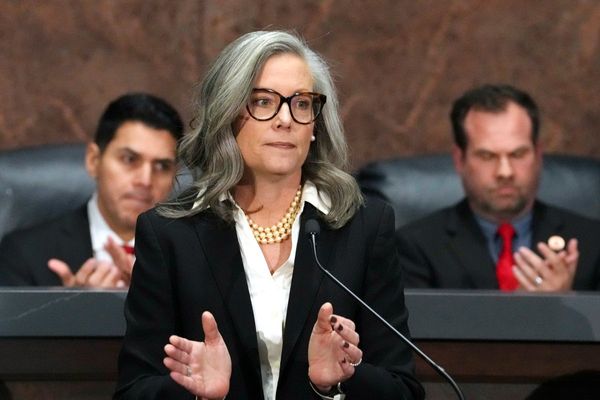
My class had been using the story of the three little pigs as the basis for our term topic, when the Guardian printed the three little pigs open journalism advert. I thought it was a great opportunity to use this to develop the pupils' understanding of what justice means.
The children had great fun making up characteristics for the three pigs. We discovered that the youngest one loved to exercise, play football, jog and do all sorts of team sports, while the middle one was a little obsessed with computer games, especially his beloved X-box. And the oldest one was a cleaning fanatic, tidying and cleaning all the time - he liked everything to be spotless!
The children felt very angry towards the despicable wolf, who had blown down two of the houses that had taken so long to build, and eaten two of the pigs! They thought the third pig must be very scared for his own life and his lovely house, and could not imagine living life so fearful!
But then the children received a surprise letter from the Wolf himself, who was now in jail, requesting they hear his side of the story: The True Story by A Wolf. The class was split, with some on the Wolf's side and some on the pigs'.
The Wolf's side argued that a large percentage of us eat bacon too. The pigs' side felt very sad for the families of the pigs, and for all the hard work they had put into building their houses!
The day after this debate, I opened the Guardian to find a two page spread on the pigs. The timing was perfect! It was a superb opportunity to widen our project, using The Guardian as a tool to enhance teaching and learning. Imagine their (and my) surprise when it turned out that the three little pigs were alive and well, and in the Guardian paper, on their way to the court house. I brought the paper into school, and the children were thrilled. They assumed it must have been their discussions that had brought the matter to the attention of the media.
Following on from these exciting developments, the Guardian released onto their website and TV the short clip of what had seemed to have happened. Well, the children were beside themselves with excitement, they wanted to know where everyone in the clip had got their evidence. They wanted to find out what the wolf's motives were, and how the pigs reacted.
The learning, enthusiasm and debates that arose as a result were inspired! At first, before the Guardian had released their video clip, we had started down a different route: the wolf had eaten the first two pigs and was in jail waiting for an appeal. But after the children saw the clip, they decided that the pigs had "placed" bacon in their houses, expecting they would be blown down, to tempt the wolf and make him look bad, when actually they were alive and well. The pigs had also put out a pot of boiling water to get the wolf, and he had burned his bottom!
It looked as if it might all have been a conspiracy: the pigs seemed to have set Wolf up to look bad! But in fact the Wolf was proved to have asthma. Some of the children in the class suffer from asthma, and, feeling a connection with the wolf, they used this in their arguments for the Wolf's innocence.
They explained how hard it could be to breathe at times, and therefore impossible for the wolf to blow down any houses. The class was already split over who was in the right, but after the Guardian article, even more of the children joined the Wolf's side.
They had debates over who was in the right and who was in the wrong, some strongly agreeing with the statements on the clip, and some coming up with their own ideas and arguments Others used the information in the clip to delve even further into the different sides of the story.
The enthusiastic learning that resulted from this was absolutely fantastic. The Guardian was advertising open journalism, and these children were doing exactly that, putting their own ideas, opinions and arguments forward to try and persuade others.
They all wanted to have their say. Some remained strongly on the side of the pigs:
"If there was someone I thought was bad that might come to my house, I'd leave out a pot of boiling water too, they're just trying to protect their homes!"
"Where will second pig play his X box now?! It's so sad for him."
"Third pig loves cleaning and loves his home. Imagine going to all that trouble and then thinking someone might blow it down, and imagine the mess! Third pig would hate that! Of course he would want to leave a pot of boiling water!"
Others felt very strongly that Wolf was innocent:
"He had asthma, he couldn't have done it."
"Mummy Wolf would be so sad. He was a good wolf, and just went to the pigs' houses to get a cup of sugar for his dear old sick granny!"
"Yeah, he is such a good wolf caring for his granny."
Others believed the Wolf had blown down the houses, but had not done it on purpose:
"I think he did it, but by accident. It would not have been by huffing and puffing, it must have been a sneeze, by accident. The powder from his inhaler made him sneeze."
The class decided we needed to have a court case to decide once and for all: Was the Wolf innocent or guilty?!
The court case was very revealing. The children used the information in the Guardian clip, but also came up with a variety of their own very plausible ideas.
After all the evidence was heard, and all the points of view and the arguments for and against were done, the jury decided the wolf was innocent! The decision was not unanimous but a majority vote was reached, and the class accepted the decision of the jury.
This project has been a fantastic opportunity to explore a more holistic approach to education, covering a variety of areas such as literacy, citizenship, health and well being, ICT and media.
• Sarah Hynie is the current primary two teacher at Canongate in St. Andrew's, Fife. This is her fourth year as a teacher, having previously taught in Glasgow and Spain, she came back to Fife, where she is originally from, to work in Canongate.
Resources on GTN and the Guardian
Sarah Hynie's lesson on the Three Little Pigs using the Guardian
Watch the Three little pigs Guardian advert video here
The Guardian's Three Little Pigs ad: behind the scenes - in pictures
Images from the making of the Guardian's new advertising campaign. Get a closer look at the detailing in the film, how we created crowd scenes and some candid moments of the actors off duty.
For teachers and older students: Guardian editor Alan Rusbridger on Guardian's approach to open journalism
This content is brought to you by Guardian Professional. Sign up to the Guardian Teacher Network to get access nearly 100,000 pages of teaching resources and join our growing community.
Could you be one of our bloggers?
Do you have something you want to share with colleagues – a resource of your own and why it works well with your students, or perhaps a brilliant piece of good practice in teaching or whole school activity that you know about it? If so please get in touch. If you would like to blog on the Guardian Teacher Network please email emma.drury@guardian.co.uk and please don't be shy about commenting on blogs on this page.







